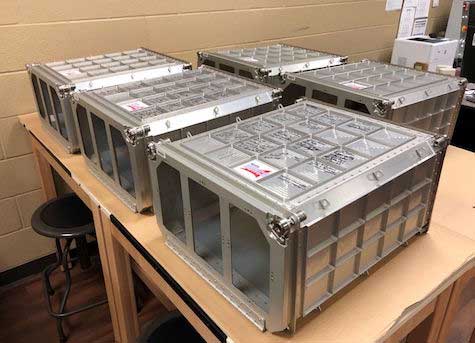Parts made by Orleans Career and Tech Center class will join NASA in space
Press Release, Orleans/Niagara BOCES

Photos courtesy of Orleans/Niagara BOCES: Orleans/Niagara BOCES students made these stowage lockers for the NASA HUNCH program.
MEDINA – Orleans/Niagara BOCES is very excited about Wednesday’s NASA launch with Crew Dragon! The stowage lockers, made by the Orleans Career and Technical Education Center’s Advanced Manufacturing and Engineering (AME) Class, will be onboard.
The class is a member of NASA’s HUNCH program. The HUNCH mission is to empower and inspire students through a Project Based Learning program where high school students learn 21st century skills and have the opportunity to launch their careers through the participation in the design and fabrication of real-world valued products for NASA.
The senior students’ signatures are on them and the juniors will add their signatures to the next round this fall. The lockers will store payloads, tools and supplies that the astronauts will need to conduct science and research on the International Space Station.
“Talk about a proud moment for the AME students, our entire school and the local districts,” said Advanced Manufacturing and Engineering teacher Bill Rakonczay.
Nancy Hall, HUNCH Project Manager, invited all the students who participated to be special guest for the takeoff #LaunchAmerica.
“The launch of our astronauts from American soil is a historic event,” Hall said. “We want you all to help celebrate this launch by participating virtually. This launch is made even more momentous for HUNCH students in manufacturing classes, because four of the single stowage lockers that they fabricated are on the crew Dragon. Thank you all so very much for your outstanding dedication and support. Enjoy the launch and stay well!”

NASA astronauts Robert Behnken and Douglas Hurley now are at the agency’s Kennedy Space Center in Florida to start final preparations for NASA’s SpaceX Demo-2 test flight. The mission is targeted for lift off at 4:33 p.m. EDT on Wednesday aboard a SpaceX Crew Dragon spacecraft carried by a Falcon 9 rocket – the first launch of American astronauts from American soil to the International Space Station in nearly a decade.
Demo-2 will be SpaceX’s second spaceflight test of its Crew Dragon craft and its first test with astronauts aboard. This final test flight prior to NASA certification will provide data on the performance of the Falcon 9 rocket, the Crew Dragon and ground systems, as well as in-orbit, docking, and landing operations.
The Falcon 9 rocket will launch from Kennedy’s historic Launch Complex 39A. But, the excitement will be felt across the country and around the world, with virtual launch parties and other events to help usher in this new era of spaceflight as NASA and its commercial partners take the next bold step toward sending the first woman and the next man to the Moon by 2024 as part of the agency’s Artemis program.
Live video coverage and countdown commentary begin at 12:15 p.m. May 27. Watch the launch and all prelaunch activities on NASA TV, YouTube, Twitter, Facebook, and Linkedin. You also can share reasons you are excited for the launch on Instagram, Twitter or Facebook with the hashtag #LaunchAmerica for a chance to be shared on our social media channels.
The Demo-2 mission will be the final major step before NASA’s Commercial Crew Program certifies Crew Dragon for operational, long-duration missions to the space station. This certification and regular operation of Crew Dragon will enable NASA to continue the important research and technology investigations taking place onboard the station, which benefits people on Earth and lays the groundwork for future exploration of the Moon and Mars starting with the agency’s Artemis program.





































































